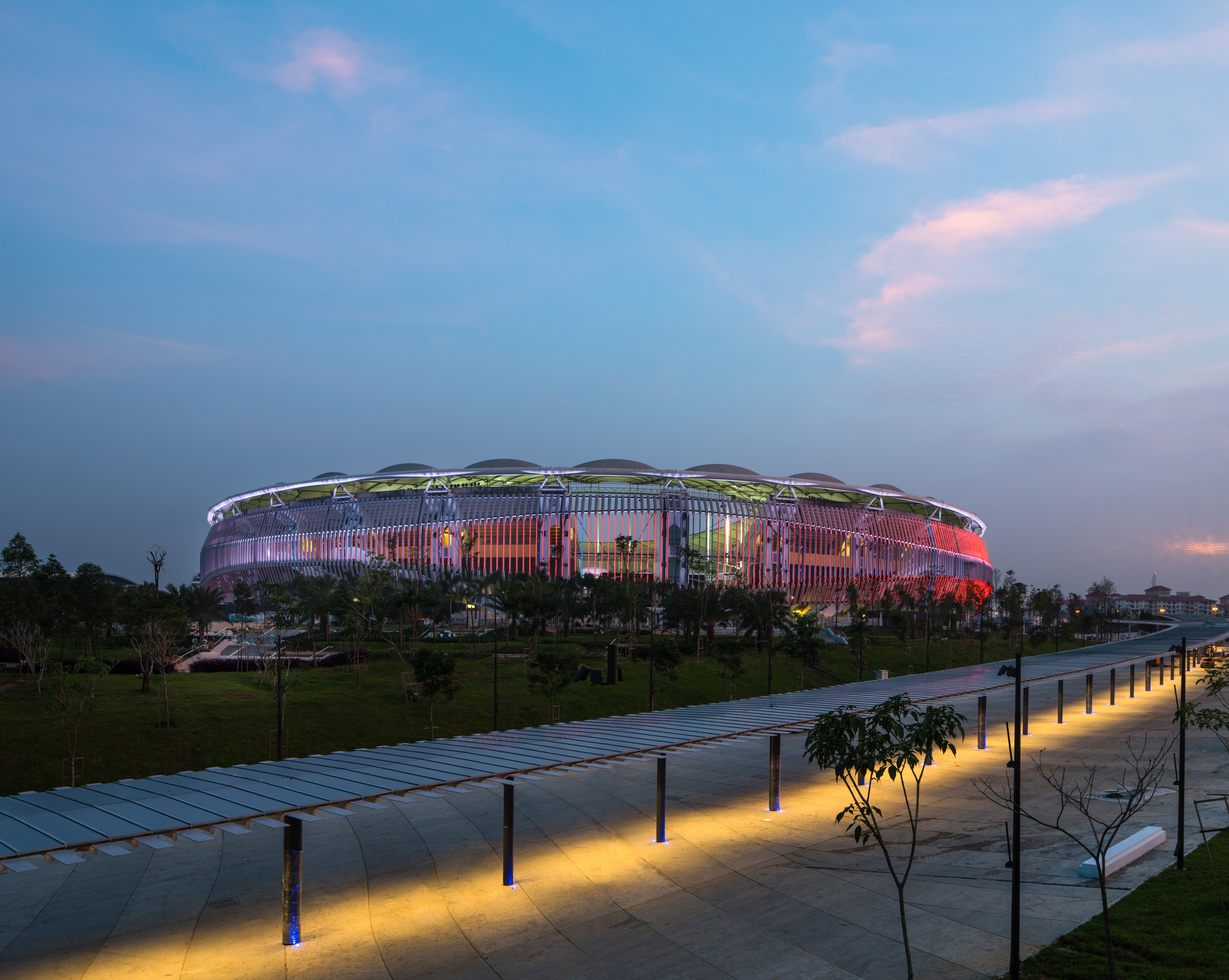
KL4-A canopy walkway linking KL Sports City to the train station makes it accessible to sports fans.
KUALA LUMPUR—Twisted blades wrap the old stadium. Like a huge accordion that goes all the way round, the structure looks striking by day and glows proudly at night.
All set to impress for the 2017 Southeast Asian Games, Kuala Lumpur clearly did more than just a facelift for the Bukit Jalil National Stadium, ground zero for Malaysia’s sporting extravaganzas for two decades.
“It’s like we stripped it to the bones and gave it new flesh and skin,” says Nalgunalingam Satgunalingam, general manager of Malaysian Resources Corp. Berhad (MRCB), a leading urban property and infrastructure company tasked to develop the sprawling Kuala Lumpur Sports City.
Up close, all the 678 blades look different—they twist at various points to give the facade a wave-like design from a distance. But the new National Stadium is more than just a visual treat.
“Attaching such a dynamic facade to an existing building is quite complex,” says project architect Brett Wightman of Populous, a global architectural design firm that developed world-class venues like the London Olympics Stadium, the Yankee Stadium and even the Philippine Arena in Bulacan three years ago.
KL7-Check out the pixelated seats at the National Stadium. It’s a design concept that gives the illussion of a crowd even if the stadium is empty.
“Each one of those twists is custom-made,” adds Wightman. “These blades twist for a reason. The top part of it is flat—what that does is it blocks the sun. And as it turns vertical, it starts twisting that allows natural ventilation.”
Light-emitting diodes (LED) also line every groove, which can turn the stadium into a spectacular light show. “It has a three-dimensional dynamic facade,” says Nalgunalingam.
“Each one of those blades can be programmed into any kind of color, any kind of graphic, dynamic pattern,” says Wightman. “It almost becomes a big digital wall. So we can have images, logos, bouncing balls going across the facade, which can be interesting at night.”
Inside, the refurbished stadium looks just as stunning. It boasts a seating capacity of 85,700, a new blue athletics track and football pitch, modern locker rooms, luxurious suites, high-definition big screens and state-of-the-art lights and sounds.
“The new seating has a pixelated effect,” Nalgunalingam points out. “It means if the stadium is empty, with the different colors that we use, it will look as if the stadium is full capacity.”
KL8-Check out the pixelated seats at the National Stadium. It’s a design concept that gives the illussion of a crowd even if the stadium is empty.
Aside from the National Stadium—which was recently shortlisted as a finalist at the World Architecture Festival 2017 in Berlin—MRCB and Populous also worked their magic on the National Aquatic Centre, the Axiata Arena and the National Hockey Stadium inside the complex in just over a year.
Inquirer got invited to preview the sports complex in a recent regional media tour.
“Out of all the projects we’ve done around the world, we’ve done this project in record time,” says Wightman. “When we do this kind of project in other countries, it can take up to 30 months. This took 15 months. So it’s absolutely amazing.”
But it’s no rush job. From form (note the unique perforated steel facade of the Axiata Arena, where badminton will be played) to function (check the movable floor of the warm-up pool at the National Aquatic Centre, which can go all the way up and serve as a multifunction space), everything has been well thought, planned and executed in the RM500 million (about P5.9 billion) project.
KL15-The warm-up pool at the National Aquatic Centre has a movable floor that can go all the way up and serve as a multi-functional space.
How Malaysia impressively rejuvenated its sports facilities would make many Filipinos wish for the same for the historic yet dilapidated Rizal Memorial Sports Complex.
It only has a 25,000-seat track and field stadium and virtually all facilities desperately need a major upgrade, but taking cue from Malaysia, beauty can be uncovered even in the oldest of monuments.
KL’s sports complex—which will have a second phase of construction after the Games and include a commercial area—also features a canopy walkway linked to the train station.
KL18-The KL Sports City makes sure it has ample green space as thousands of trees and shrubs nestle inside the complex.
“When you come from the MRT station, most likely you’ll get roasted before you reach here,” says Nalgunalingam. “So we now have a covered walkway that also gives an experience of a grand arrival to the stadium.”
There’s even ample green space as thousands of trees and shrubs nestle inside the complex. “There are different kinds of levels in the plaza where people can rest,” says Wightman. “We want people to spend a lot of time in this space.”
The athletes, of course, will be the star of the show when the SEA Games fires off on Aug. 19. But with the impressive KL Sports City as backdrop, it will surely make the region’s sporting spectacle a marvel.

